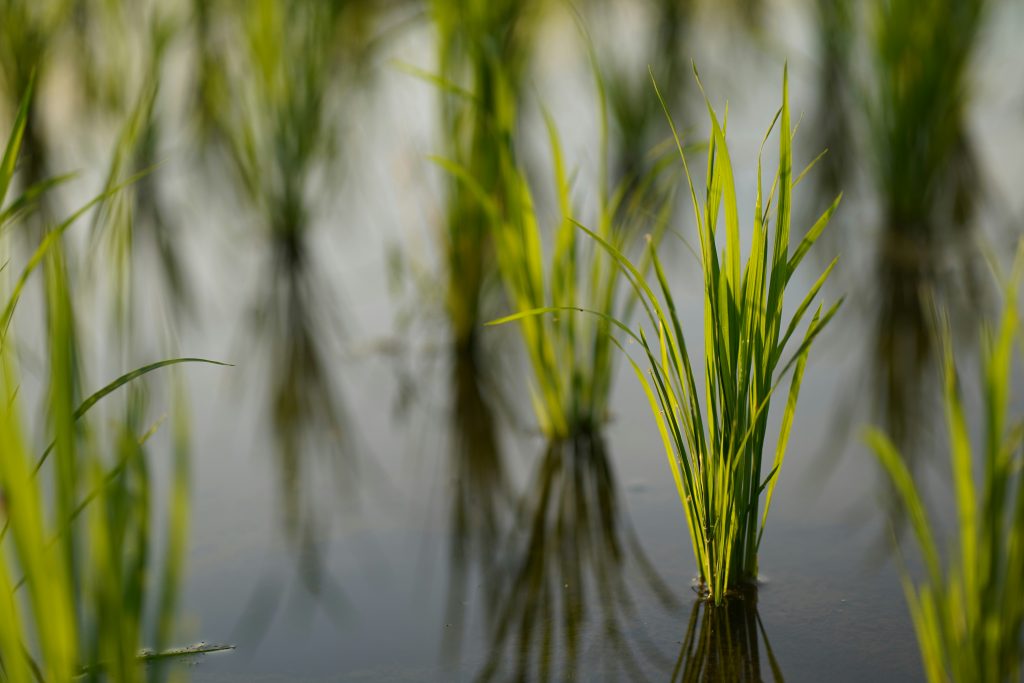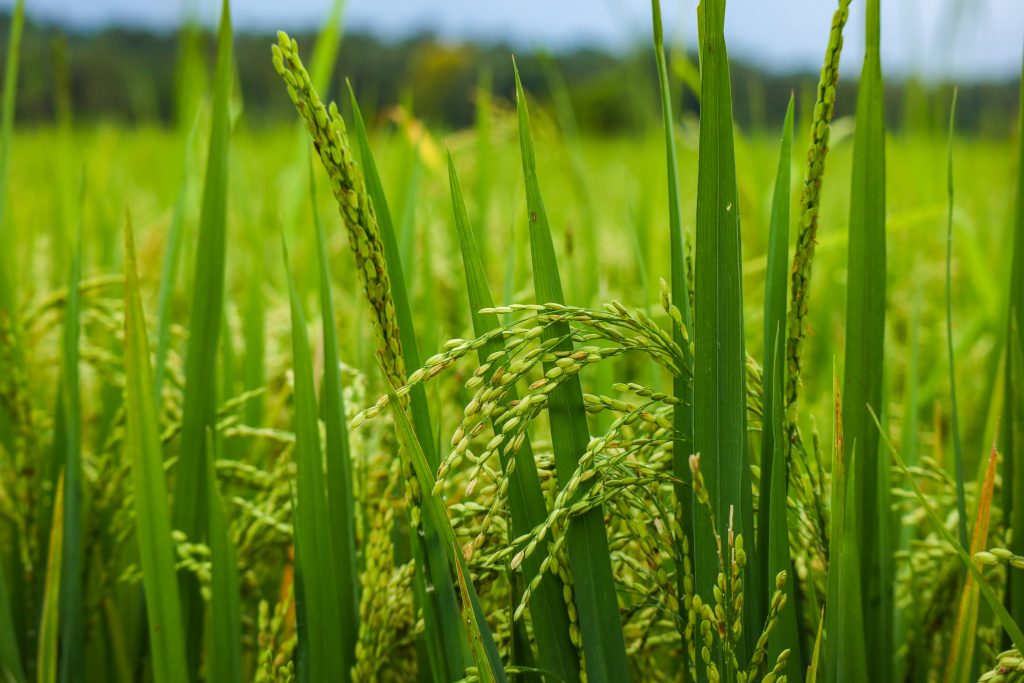Introduction
In the global fight against climate change, carbon credits have emerged as a crucial tool for offsetting emissions and incentivizing sustainable practices. Essentially, a carbon credit represents a ton of carbon dioxide or its equivalent in other greenhouse gases (GHGs) that has been removed or reduced from the atmosphere. These credits can be traded in markets, offering financial rewards for entities that achieve measurable emissions reductions.
Agriculture, a sector both vital and vulnerable to climate change, has a significant carbon footprint, with rice cultivation standing out due to its extensive water use and methane emissions. However, this also means rice cultivation holds substantial potential for generating carbon credits through innovative and sustainable practices, a concept gaining momentum globally.
Rice Cultivation and Its Environmental Impact
Rice cultivation, important for global food security, is also a significant source of environmental impact, particularly in terms of water usage and greenhouse gas emissions. The traditional practice of continuous flooding in rice paddies, essential for rice growth, creates anaerobic conditions conducive to methane production. Methane, a potent greenhouse gas, is released during the decomposition of organic matter in the waterlogged soils of rice fields. This process contributes substantially to the agricultural sector’s methane emissions, which are a critical factor in global warming and climate change.
In addition to methane, rice cultivation can also emit nitrous oxide, another potent greenhouse gas, through the application of nitrogen-based fertilizers. These fertilizers, when applied to rice fields, can lead to the conversion of nitrogen in the soil into nitrous oxide, further exacerbating the carbon footprint of rice production. The combination of methane and nitrous oxide emissions makes rice cultivation one of the most significant agricultural sources of greenhouse gases.
Water usage is another critical environmental concern associated with rice cultivation. Rice is one of the most water-intensive crops, requiring large quantities of water for irrigation. In many parts of the world, this leads to significant stress on water resources, particularly in regions where water scarcity is already a pressing issue. The extensive withdrawal of water for rice irrigation can deplete local water reserves, affect groundwater levels, and disrupt the natural flow of rivers and streams, impacting biodiversity and the availability of water for other uses.
The environmental impact of rice cultivation is further compounded by land use changes, such as deforestation and the conversion of wetlands to rice paddies. These changes can lead to the loss of natural habitats, a decrease in biodiversity, and the release of carbon stored in vegetation and soils, contributing to increased atmospheric CO2 levels.
Given the global dependence on rice as a staple food, addressing the environmental impacts of its cultivation is crucial. Sustainable practices and technologies are being developed and implemented to reduce the carbon and water footprints of rice production. These include water-saving irrigation methods, such as alternate wetting and drying (AWD), and the use of specially bred rice varieties that require less water and are more resistant to pests and diseases. By adopting such practices, the rice agriculture sector can significantly mitigate its environmental impact while continuing to provide a vital food source for billions of people worldwide.

Mechanisms of Generating Carbon Credits from Rice Cultivation
The generation of carbon credits from rice cultivation involves implementing and verifying practices that reduce greenhouse gas emissions or enhance carbon sequestration in agricultural systems. These mechanisms are grounded in sustainable agricultural methodologies that not only contribute to the mitigation of climate change but also support the resilience and productivity of rice farming.
One of the primary methods for reducing emissions in rice cultivation is through water management techniques, such as the Alternate Wetting and Drying (AWD) system. AWD involves intermittently flooding rice fields and then allowing them to dry before re-flooding, as opposed to the traditional continuous flooding method. This technique significantly reduces methane emissions by limiting the time water stands in the fields, thereby reducing the anaerobic conditions that lead to methane production. Implementing AWD can be a complex process that requires careful monitoring of water levels, soil moisture, and plant health, but it offers a viable way to reduce the carbon footprint of rice cultivation.
The use of biochar in rice fields represents another innovative approach to generating carbon credits. Biochar is a stable, carbon-rich form of charcoal that can be added to soil to improve its fertility and water-holding capacity. When incorporated into rice paddies, biochar not only enhances soil health and crop productivity but also sequesters carbon for long periods, preventing it from contributing to atmospheric CO2 levels. This carbon sequestration process is a critical element in the creation of carbon credits, as it represents a net removal of carbon from the atmosphere.
Additionally, the development and adoption of improved rice varieties that are more efficient in nutrient use and resistant to pests and diseases can lead to reduced requirements for synthetic fertilizers and pesticides. This, in turn, decreases the emissions associated with the production and application of these agrochemicals. Some rice varieties are also bred to produce less methane during their growth cycle, further contributing to emissions reductions.
Beyond direct agricultural practices, carbon credits can also be generated through landscape-level interventions such as the restoration of degraded lands and the implementation of agroforestry systems around rice paddies. These practices increase the biomass and organic matter in the ecosystem, enhancing its capacity to sequester carbon.
For carbon credits to be generated, the emissions reductions or carbon sequestration achieved through these practices must be quantifiable, verifiable, and beyond what would have occurred under a ‘business as usual’ scenario. This involves rigorous monitoring, reporting, and verification (MRV) processes to ensure the integrity of the carbon credits. The development of robust MRV frameworks tailored to the complexities of rice cultivation is crucial for accurately quantifying the impact of these sustainable practices and translating them into tradable carbon credits.
By harnessing these mechanisms, rice cultivation can transition from a significant source of greenhouse gas emissions to a sector that actively contributes to climate change mitigation, providing a sustainable pathway for the agricultural industry while supporting global environmental goals.
Benefits to Farmers
Integrating carbon credit schemes into rice cultivation can offer multiple benefits to farmers, serving as both a catalyst for adopting sustainable agricultural practices and a source of additional income. By participating in carbon credit projects, farmers can access new revenue streams through the sale of credits generated by their emissions-reducing practices. This financial incentive encourages the adoption of innovative cultivation techniques that not only contribute to global climate change mitigation efforts but also enhance farm productivity and resilience.
For instance, practices like the Alternate Wetting and Drying (AWD) method not only reduce methane emissions but can also lower water usage, decrease farming costs, and potentially increase yields. Moreover, engaging in carbon credit projects often involves access to training, resources, and support networks that empower farmers with knowledge and tools to improve their agricultural practices. This can lead to better soil health, reduced vulnerability to pests and diseases, and increased food security.
Furthermore, sustainable farming practices associated with carbon credits can improve the long-term sustainability of agricultural land, ensuring that farmers can continue to cultivate their land for generations. The global recognition and support for such environmentally friendly practices can also open up new markets for sustainably produced rice, further enhancing farmers’ incomes and market opportunities.
Challenges and Opportunities in Rice-Based Carbon Credit Projects
While the potential for carbon credits from rice cultivation is significant, several challenges need addressing. Measuring, reporting, and verifying (MRV) emissions reductions accurately is complex in agricultural settings. Additionally, smallholder farmers, who constitute the majority of rice producers, may lack the resources and knowledge to implement sustainable practices without support.
Despite these challenges, rice-based carbon credit projects offer numerous opportunities. They can provide additional income streams for farmers, promote sustainable agricultural practices, and contribute to local and global environmental benefits. Engaging farmers through cooperatives or partnerships with governments and NGOs can facilitate the adoption of sustainable practices and participation in carbon credit markets.
Case Studies and Success Stories
Case studies below exemplify the diverse approaches to generating carbon credits in rice cultivation, from direct agricultural practices to broader landscape-level interventions. They demonstrate the feasibility and benefits of such initiatives, providing valuable lessons and inspiration for scaling up carbon credit schemes in rice cultivation globally.

Vietnam’s Mekong Delta Project: In the Mekong Delta region of Vietnam, a pioneering project implemented the Alternate Wetting and Drying (AWD) technique across thousands of hectares of rice fields. This initiative not only reduced methane emissions significantly but also conserved water and lowered irrigation costs for local farmers. The project’s success led to the generation of a substantial number of carbon credits, which were then sold on the international market, providing additional income to the participating farmers. The initiative served as a model for sustainable rice cultivation, demonstrating the environmental and economic benefits of carbon credit projects in agriculture.
California Rice Commission’s Protocol: In the United States, the California Rice Commission developed a protocol for methane emissions reductions from rice cultivation, which was adopted by the California Air Resources Board. This protocol allowed rice farmers in California to generate carbon credits by implementing practices that reduce methane emissions, such as dry seeding and early drainage at the end of the growing season. The generated credits are sold in California’s cap-and-trade market, providing a financial incentive for farmers to engage in sustainable practices and contributing to the state’s greenhouse gas reduction goals.
The SRI International Network and Resources Center (SRI-Rice): The System of Rice Intensification (SRI) is a set of agricultural practices that aim to increase the productivity of rice cultivation while using less water and fewer inputs. SRI-Rice, a program at Cornell University, has supported the implementation of SRI methods in over 50 countries, leading to increased yields, reduced water usage, and lower methane emissions. Although not all SRI projects are directly linked to carbon credit markets, the environmental benefits achieved mirror those necessary for carbon credit generation, showcasing the potential for SRI practices to contribute to carbon credit schemes.
Indonesia’s Peatland Restoration Effort: In Indonesia, efforts to restore degraded peatlands—often converted into rice paddies—have demonstrated significant potential for carbon sequestration. Restoring peatlands involves re-wetting drained areas and reintroducing native vegetation, which can capture and store large amounts of carbon over time. While these projects primarily focus on peatland restoration, they highlight the possibilities for incorporating rice cultivation into broader landscape restoration efforts, generating carbon credits through enhanced carbon storage and reduced emissions.
Conclusion
The potential of carbon credits from rice cultivation is an exciting frontier in sustainable agriculture and climate change mitigation. By addressing the challenges and scaling up successful practices, the sector can contribute significantly to global environmental goals. The future holds promise for expanding these initiatives, with a collective effort from farmers, governments, NGOs, and the private sector driving forward this green revolution in rice cultivation.
References
- GRAIN (n.d.) Carbon rice farming: A license to pollute at the expense of small farmers. Available at: https://grain.org/en/article/7009-carbon-rice-farming-a-license-to-pollute-at-the-expense-of-small-farmers.
- Economic Times (n.d.) Indian farmers rack up carbon credits with climate-conscious ways. Available at: https://economictimes.indiatimes.com/news/economy/agriculture/indian-farmers-rack-up-carbon-credits-with-climate-conscious-ways/articleshow/105380884.cms.
- CGIAR (n.d.) Milestone carbon credit methodology for rice launched with help from IRRI. Available at: https://www.cgiar.org/news-events/news/milestone-carbon-credit-methodology-for-rice-launched-with-help-from-irri/.
- Carbon Streaming (n.d.) Nalgonda rice farming. Available at: https://www.carbonstreaming.com/project/nalgonda-rice-farming/.
- Gold Standard (n.d.) New methodology to slash methane emissions from rice cultivation and empower smallholder farmers. Available at: https://www.goldstandard.org/news/new-methodology-to-slash-methane-emissions-from-rice-cultivation-and-empower-smallholder-farmers.
- Rikolto (n.d.) Carbon credits at the service of farmers: Piloting innovation. Available at: https://www.rikolto.org/projects/carbon-credits-at-the-service-of-farmers-piloting-innovation.
- Energy Monitor (n.d.) Can soil carbon credits benefit farmers and help the climate? Available at: https://www.energymonitor.ai/policy/carbon-markets/can-soil-carbon-credits-benefit-farmers-and-help-the-climate/.
- Global Goals (n.d.) 437 LUF AGR Methane Emission Reduction AWM Practice in Rice. Available at: https://globalgoals.goldstandard.org/437-luf-agr-methane-emission-reduction-awm-practice-in-rice/.
- Climate Change News (2023) Revealed: How Shell cashed in on dubious carbon offsets from Chinese rice paddies. Available at: https://www.climatechangenews.com/2023/03/28/revealed-how-shell-cashed-in-on-dubious-carbon-offsets-from-chinese-rice-paddies/.
- PwC UK (n.d.) Agricultural carbon markets. Available at: https://www.pwc.co.uk/assets/pdf/agricultural-carbon-markets.pdf.
- IISD (n.d.) Progresses and challenges implementing JCM under Article 6 Paris Agreement. Available at: https://enb.iisd.org/progresses-and-challenges-implementing-jcm-under-article-6-paris-agreement.
About GreenUP
Pioneering the Green Transition with Expertise and Innovation. With over 10 million I-RECs issued since 2019, we are Vietnam’s leaders in renewable energy certification. Our comprehensive suite of services, positions us uniquely as a one-stop solution for all your green and ESG needs. Experience unparalleled market access, competitive pricing, and strategic partnerships that drive not only cost savings but also significant value to your sustainability goals.







